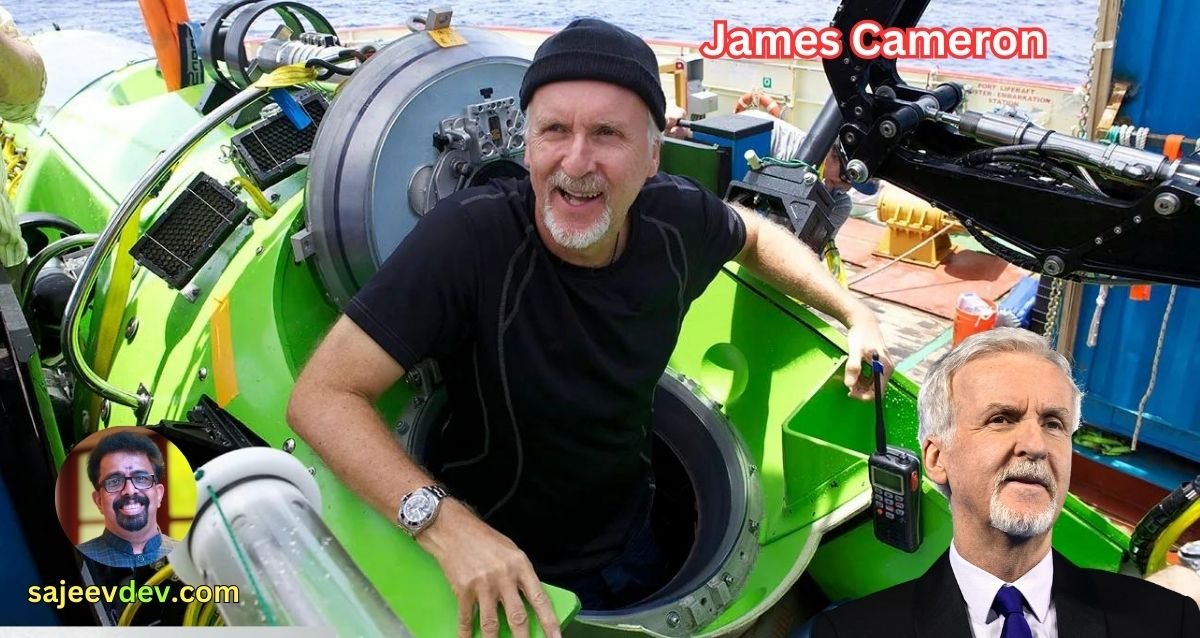James Cameron
James Francis Cameron, born on August 16, 1954, in Ontario, Canada, has firmly established himself as a transformative figure in the world of modern cinema and exploration. Emerging in the post-New Hollywood era, Cameron has consistently pushed the boundaries of cinematic technology and storytelling. His pioneering spirit extends beyond filmmaking to deep-sea exploration, demonstrating his multifaceted contribution to both art and science.
Cameron’s career soared with his knack for blending cutting-edge technologies with timeless narrative styles. From the groundbreaking special effects in “The Terminator” and “Aliens” to the revolutionary motion capture and 3D technology used in “Avatar,” his films are often technological milestones that set new standards in the industry. These advancements underline his role as an innovator who continually reshapes the landscape of filmmaking.
However, Cameron’s influence is not confined to the silver screen. His ventures into environmentalism and oceanographic exploration highlight his commitment to preserving and understanding the natural world. Notably, his deep-sea explorations, including his record-breaking solo dive to the Mariana Trench, underscore his dedication to expanding human knowledge and addressing environmental concerns.
This blog post delves into the myriad facets of James Cameron’s career, examining his pioneering contributions to cinema, his technological innovations, and his ardent advocacy for environmental conservation. Through this exploration, it becomes evident that Cameron is not only a filmmaker of extraordinary vision but also an explorer driven by an insatiable curiosity and a deep-seated respect for our planet.
Early Success in Filmmaking
James Cameron’s early career in filmmaking is noteworthy for its groundbreaking innovations and enduring impact on the industry. One of his most significant early successes was ‘The Terminator’ (1984), a film that seamlessly blended science fiction with action, creating a compelling narrative that introduced audiences to the now-iconic character of the Terminator. This project showcased Cameron’s distinctive approach to filmmaking, one that combined cutting-edge technology with a strong storyline, setting a precedent for his future works. The success of ‘The Terminator’ firmly established him as an emerging force in Hollywood.
Cameron’s talent for merging advanced technology with captivating narratives continued with ‘Aliens’ (1986). This sequel to Ridley Scott’s ‘Alien’ (1979) was both a critical and commercial triumph. By integrating innovative special effects and creating a gripping storyline, Cameron managed to craft a movie that differed from its predecessor while maintaining the franchise’s core themes. This film not only highlighted his ability to handle sequels but also demonstrated his expertise in pushing the boundaries of cinematic technology and visual storytelling.
His ambition was further evident in ‘The Abyss’ (1989), a film that explored the depths of the ocean and featured pioneering underwater filming techniques. The movie’s groundbreaking visual effects were crucial in portraying its unique settings and contributed significantly to the narrative’s immersive experience. Cameron’s ability to employ novel filming methods continued to distinguish his work from that of his contemporaries, further cementing his reputation as an innovator.
With ‘Terminator 2: Judgment Day’ (1991), Cameron once again redefined the action and science fiction genres. The film’s use of then-revolutionary computer-generated imagery (CGI) led to some of the most memorable scenes in cinematic history. Its commercial and critical acclaim underscored Cameron’s mastery in blending advanced technologies with powerful narratives.
Continuing his streak of success, ‘True Lies’ (1994) allowed Cameron to delve into the action-comedy genre, showcasing his versatility and his continued commitment to integrating impressive special effects with engaging storytelling. Through these early films, James Cameron established himself not only as a filmmaker keen on pioneering new technologies but also as a storyteller capable of captivating audiences with innovative and compelling narratives.
Titanic: A Monumental Achievement
James Cameron’s “Titanic” (1997) stands as a testament to his relentless pursuit of cinematic excellence and innovation. Garnering three Academy Awards for Best Picture, Best Director, and Best Film Editing, “Titanic” not only showcased Cameron’s storytelling prowess but also pushed the boundaries of filmmaking technology. The production of “Titanic” was a monumental undertaking fraught with challenges that tested the limits of Cameron’s vision and tenacity.
One of the primary hurdles was the sheer scale and ambition of the project. Cameron sought to create a realistic and immersive experience, necessitating the construction of an immense, almost full-scale replica of the RMS Titanic. This massive set was built in Baja, Mexico, in a specially constructed tank, allowing for unprecedented control over the aquatic environment. The attention to detail was meticulous, from the grand staircase down to the intricately designed costumes, all aiming to faithfully recreate the opulence of the early 20th century.
Cameron’s innovative approach extended to the film’s groundbreaking visual effects. Utilizing a combination of practical effects, detailed miniatures, and pioneering computer-generated imagery (CGI), he achieved a seamless blend of real and virtual elements. Notably, the iconic sinking sequence remains one of the most technically sophisticated film moments ever created. Cameron’s commitment to authenticity also saw him dive to the actual Titanic wreckage twelve times, capturing real footage that added an extra layer of depth and realism to the film.
“Titanic” proved to be an unprecedented box office success, grossing over $2 billion worldwide, making it the highest-grossing film at the time. Its impact extended beyond the commercial sphere, resonating deeply with audiences and critics alike. The film’s universal themes of love, loss, and human resilience, paired with Cameron’s relentless attention to detail and storytelling, cemented “Titanic” as an enduring cultural phenomenon.
The legacy of “Titanic” in cinema history is profound. It demonstrated the potential of pushing technological and narrative boundaries, inspiring countless filmmakers to pursue ambitious projects. Moreover, it reaffirmed the idea that great storytelling, combined with innovative techniques, can create timeless works of art. James Cameron’s “Titanic” remains a monumental achievement in modern filmmaking, both for its artistic and technical brilliance.
Avatar: Revolutionizing Cinema
James Cameron’s “Avatar” (2009) represents a monumental shift in the fabrics of filmmaking, primarily due to its groundbreaking advancements in 3D technology and visual effects. The film’s innovative use of digital 3D Fusion Camera System, co-developed by Cameron himself, redefined how audiences experienced cinema. This technological marvel pushed the boundaries of what was previously thought possible in visual storytelling, positioning “Avatar” as a pivotal moment in the industry.
The Fusion Camera System enabled highly immersive 3D experiences by capturing images in a more lifelike way than traditional technology allowed. These advancements can be seen in the rich, vibrant world of Pandora, bringing an unparalleled depth and realism to every frame. The photorealistic renderings of characters and environments showcased the potential of blending CGI with real-world elements, marking a significant departure from previous digital effects.
The impact of “Avatar” on the filmmaking landscape cannot be overstated. The movie was not just a technical feat but also a financial juggernaut. Garnering over $2.8 billion globally, it was, until recently, the highest-grossing film of all time, a title it held for nearly a decade. Such success is a testament to Cameron’s visionary approach and the universal appeal of the film’s innovative techniques. The financial triumphs of “Avatar” have ensured that its technology and methodologies would influence countless projects in the years that followed.
The forthcoming sequels to “Avatar” promise to build on this legacy, continuously pushing the envelope in cinematic technology and storytelling. With upcoming installments already generating buzz, Cameron’s work on “Avatar” and its sequels is anticipated to set new benchmarks in the film industry once again. As these films continue to shape the future, their foundation in technological innovation and narrative ambition remains Cameron’s most enduring contribution to modern filmmaking.
Industry Impact and Recognition
James Cameron’s contributions to the film industry extend far beyond his role as a director. Known for his relentless pursuit of inventive filmmaking techniques and his dedication to pushing the boundaries of what cinema can achieve, Cameron has left an indelible mark on the industry. His innovation is best exemplified through his substantial influence on the development of tools and technologies that revolutionized the way films are made.
Cameron’s innovative spirit led to the creation of the groundbreaking Performance Capture technology used extensively in “Avatar.” This not only enhanced the realism and emotional depth conveyed by animated characters but also set a new standard for visual effects in film. Additionally, his utilization of cutting-edge underwater filming techniques in “The Abyss” and “Titanic” further showcased his commitment to authenticity and technical excellence.
Recognition of Cameron’s unparalleled contributions has come from multiple prestigious avenues. Three of his films—”The Terminator,” “Aliens,” and “Titanic”—have been preserved in the National Film Registry by the Library of Congress for their cultural, historical, and aesthetic significance. Such an honor underscores the lasting impact of his work on the collective cinematic heritage.
Moreover, Time magazine’s inclusion of Cameron in their 2010 list of the ‘100 Most Influential People in the World’ reflects not only his achievements in filmmaking but also his broader influence on popular culture. Cameron’s ability to blend compelling narratives with visionary technology has resonated globally, earning him a unique place among the elite of the entertainment industry.
His legacy is further cemented by numerous accolades, including multiple Academy Awards and nominations, which highlight both his creative prowess and technical acumen. Through his relentless innovation and commitment to cinematic excellence, James Cameron has continually raised the bar for filmmakers, setting new industry standards and inspiring future generations of storytellers.
Exploration and Documentary Work
James Cameron’s achievements extend far beyond his celebrated feature films. As a National Geographic Explorer-in-Residence, Cameron has used his profound interest in science and technology to uncover the secrets hidden beneath the ocean’s surface. His passion for underwater exploration is vividly portrayed in his documentaries, such as Ghosts of the Abyss (2003) and Aliens of the Deep (2005).
Ghosts of the Abyss offers viewers an unprecedented look at the wreck of the RMS Titanic. Cameron, who directed the blockbuster film Titanic (1997), brought his fascination with the ill-fated vessel to life through innovative underwater filming techniques. Utilizing state-of-the-art 3D cameras and remotely operated vehicles, he provided audiences with a stunning and immersive dive into the history and remnants of the Titanic. This documentary not only satisfied public curiosity but also highlighted the fragile nature of underwater heritage sites.
Similarly, Aliens of the Deep focuses on the mysteries of the deep-sea environment. Collaborating with a team of marine biologists and NASA scientists, Cameron’s expedition explored deep-ocean hydrothermal vent sites teeming with alien-like life forms. Using advanced deep-diving submersibles, the team captured remarkable footage of creatures thriving in one of Earth’s most extreme environments. The film aimed to draw parallels between the deep ocean and potential extraterrestrial life, thus combining Cameron’s passion for both oceanography and space exploration.
Beyond filmmaking, Cameron has significantly contributed to the development of underwater filming and remote vehicle technologies. His innovations include advanced submersible designs capable of reaching the ocean’s deepest trenches. Cameron’s dedication to deep-ocean exploration culminated in his historic solo dive to the Mariana Trench in 2012, where he piloted the Deepsea Challenger to the ocean’s deepest point. This mission not only underscored his relentless pursuit of science but also expanded our understanding of the uncharted underwater world.
James Cameron’s dual career as a filmmaker and explorer demonstrates his unique ability to blend storytelling with scientific curiosity. His documentaries and technological advancements continue to inspire and influence both fields, leaving a lasting impact on how we explore and visualize our planet’s hidden realms.
Groundbreaking Ocean Exploration
In 2012, James Cameron embarked on a historic solo mission to the bottom of the Mariana Trench, diving to a depth of approximately 36,000 feet in the Deepsea Challenger submersible. This unprecedented expedition marked Cameron as the first person to make a solo descent to such a profound abyss, showcasing his unwavering commitment to exploration and innovation.
The Deepsea Challenger, meticulously designed for this audacious endeavor, was equipped with cutting-edge technology that allowed Cameron to withstand the immense pressures of the deep sea. The submersible’s lightweight composite materials, advanced ballast system, and innovative life-support apparatus were instrumental in achieving this monumental dive.
Cameron’s expedition not only set new records in oceanography but also significantly advanced our understanding of the Earth’s most mysterious and least explored environments. By collecting samples and capturing high-resolution imagery, the mission provided invaluable insights into the unique ecosystems and geological formations of the trench. These findings have since contributed to a wealth of scientific knowledge, highlighting the critical importance of deep-sea exploration in broadening our comprehension of marine biodiversity and geophysical processes.
Furthermore, the technological advancements driven by Cameron’s quest have had far-reaching implications beyond oceanography. The design and engineering breakthroughs realized during the development of the Deepsea Challenger have spurred innovations in materials science, robotics, and various other fields. Cameron demonstrated that the pursuit of such ambitious goals can lead to transformative technological progress, benefiting multiple disciplines and industries.
James Cameron’s historic solo descent into the depths of the Mariana Trench epitomizes his relentless pursuit of pushing the boundaries of human exploration. By merging his passion for filmmaking with his drive for discovery, Cameron continues to inspire future generations of explorers and innovators, reaffirming his position as a pivotal figure in both modern filmmaking and the realm of deep-sea exploration.
Environmental Advocacy and Sustainability
James Cameron’s commitment to environmental sustainability is evident both in his personal life and professional endeavors. An outspoken advocate for green living and climate change awareness, Cameron has utilized his influence to promote various environmental causes. His dedication to sustainability extends beyond advocacy; he actively incorporates these principles into his lifestyle and work, creating a holistic example of environmental stewardship.
One of Cameron’s significant contributions to environmentalism is his promotion of plant-based diets as a means to reduce carbon footprints. He and his wife, Suzy Amis Cameron, established the Plant Power Task Force, an initiative aimed at raising awareness about the environmental benefits of plant-based eating. The couple also co-founded a vegan school, MUSE School, in California, integrating sustainable practices into the curriculum to educate future generations on the importance of environmental consciousness.
Additionally, Cameron has invested in numerous sustainable business ventures. He co-founded Verdient Foods, a plant-based protein company, to produce environmentally friendly and sustainable food products. His approach towards sustainable business practices demonstrates his commitment to making tangible changes in the industry, paving the way for eco-conscious entrepreneurship.
Cameron’s passion for the environment is also reflected in his filmmaking. In “Avatar,” the highest-grossing film of all time, Cameron explores themes of environmental degradation and the interconnectedness of life, echoing his real-world concerns about sustainability. The film’s depiction of the Na’vi’s reverence for their ecosystem on Pandora serves as a powerful allegory for the importance of environmental conservation on Earth.
Overall, James Cameron’s dedication to environmental advocacy and sustainability exemplifies his multifaceted influence. By championing green living, supporting eco-friendly businesses, and integrating environmental themes into his films, Cameron continues to inspire others to consider their impact on the planet and take steps toward a more sustainable future.









